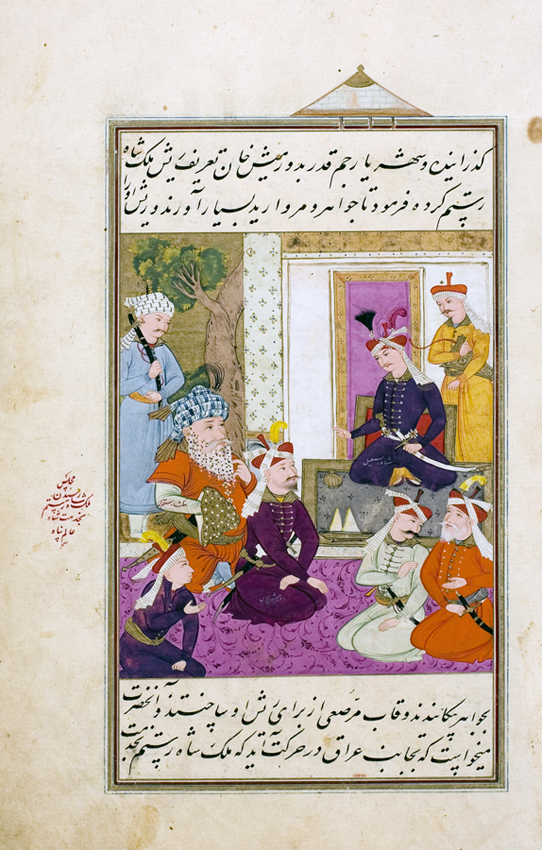At the end of 915/1508, after dealing with affairs in Arab Iraq, Esmāʿil marched on Khuzestan to subjugate that province. On the border of Lorestan, he detached a force of 10,000 under Ḥoseyn Beg Lala Šāmlu and Beyrām Beg Qarāmānlu, and dispatched them against Malek Shah Rostam, the ruler of Lorestan. Malek fled before the Safavid forces and took refuge in a mountainous region. The emirs surrounded the mountain, and his situation became desperate. He approached the emirs, and on promise of quarter and in their company went to the royal court, where he uttered sweet words in the Lori dialect and pledged his loyalty to the shah. In turn Esmāʿil presented him with a golden vessel inlaid with jewels for his beard. Malek Rostam spent some time with the shah, and was then reinstated as the governor of Lorestan.
Cf. Ms. L, f. 149v, and Ms. N, JK-298 for two other version of this subject. This composition is similar to the two others cited, and varies primarily as the result of a different space alotted to it. The British Library painting is a vertical rectangle; Ms. N, 298 is almost a square, slightly wider than it is high, while this painting is somewhere between the two. Eight figures - Esmāʿil, four qezelbāš, Malek Shah and one of his advisors - are represented. The other paintings have eight or nine figures represented, but the space alotted here allows their distribution more harmoniously. That the three versions are derived from one another, or from a common source, is attested to by small detail, such as the dish with three objects just before the shåh, which are exactly the same in both variants.
Esmāʿil is seated on a throne, shown in plan in the upper right, in front of a tiled wall. He wears a purple coat and a flat top Safavid tāj with insignia of his office. To the right is the ceremonial sword bearer. Malek Shah Rostam wears a turban, a jewel encrusted beard, and holds a bejeweled gold vessel, reportedly a covering for his beard, that was given to him by the shah. Behind him, on the left stands his ceremonial swordbearer. In the foreground are four seated qezelbāš - two on the right, one on the left, and one more prominently positioned near the center of the composition who is identified by an inscription as Durmeš Khan. The ʿālām-ārā-ye šāh esmāʿil makes no mention of who else besides Esmāʿil and Rostam were present at this event, nor for that matter which emirs were in command of the Safavid forces that overwhelmed Malek Shah Rostam. So there seems to be no evidence that Durmeš Khan was present. If Eskandar Monshi is to be believed the two qezelbāš in the lower right might be Ḥoseyn Beg Lāla Šāmlu and Beyrām Beg Qarāmānlu.
Location: Harvard Art Museums / Arthur M. Sackler Museum, Gift of Mrs. Ezzat-Malek Soudavar in honor of Tim Lentz, Acc. no. 2006.262
Folio size: 36 x 22.5 cm.
Painting: ink, opaque watercolor and gold on paper. 15.5 x 13 cm wide (scaled from folio size)
Written surface: 22.5 x 13 cm wide (scaled from folio size)
Inscriptions: In white šāh esmāʿil on the knee of the shah, in red malek šāh rostam on the arm of seated bearded figure, and in a light color on the foreleg of the seated qezelbāš near the center: durmeš ḵān.
Painting references:
Soudovar, PC_1992, p.290, fig.49 (ill. in color).
Text references:
Muntaẓer-Ṣāḥeb_1970, p.179.
See Savory, SA_1979, pp. 56-57 for this event in the History of Shah ʿĀbbās..
Robert Eng
Last Updated: November 30, 2011 | Originally published: November 30, 2011
